
YouTube attracts millions of viewers daily with a seemingly infinite catalogue of videos. While the online video hub creates the perfect online diversion, the site also acts as an amazing visual reference for viewers who seek guidance and instruction on any given topic. YouTube offers both avid and amateur hoopers inspiration for new hooping routines, amazing demonstrations of hoop acrobatics and even how-to videos to introduce kids (and adults!) to the fun of the hoop.
Hula hooping is much more than just rotating the hoop around the waist. Hooping includes acts of agility, challenging dance moves and feats of flexibility. Check out the best of YouTube’s hooping videos to discover new opportunities to get in the hoop:
Best Kid’s Hooping Dance Video:
Kids love hula hooping for the fun and silliness that hooping movements create. Challenge kids to go beyond the typical hoop routine by pulling up the best and most joyfully entertaining hooping video for kids on YouTube. Boasting almost nine-million views, the adorably sweet and happy animated character Bada Namu teaches kids new hooping dance routine in the video “Hoola Hoola Hooping.” Younger kids will love the character and the upbeat music, and even parents won’t be able to resist the temptation to dance along…because Bada has some crazy cool hoop moves! Dance, sing and hoop with Bada Namu!
Most Amazing Solo Hoop Dance Video
Rachel Lust masters the hoops in her video “Groove.” The video features Lust contorting her body with effortless ease as she positions the hoop. She amazingly rotates the hoop from her calves up her body while always keeping the hoop in motion. Her masterful movements reveal hoop skills that are worthy of study for those who want to take their routine to the next level. Set to Oiko’s techno-beat “Groove,” Lust’s moves are choreographed perfection.
Most Hypnotic Hooping Video
Turn out the lights and glow with the hoop. LED lights in hoops display a hypnotic effect as they spin in the dark. Perfect for music festivals like Ultra or Burning Man, LED hoops give dancers that techno touch as they spin and move. Hooper Lisa Lottie spins six LED hoops in her video and the result is an acrobatic hooping masterpiece that leaves viewers in a hypno-trance.
Best Hooping How-To Video for Beginners
Most adults learned to hula hoop as kids. The basics of the hoop seem simple…slip the hoop around the waist, wiggle the hips and keep the hoop in motion. However, the world of the hula hoop opens up to more complicated dance routines and challenging hoop moves. Never even picked up a hoop? Learn the very basics of hooping (start with the waist) with Deanne Love’s video “How to Hula Hoop for Total Beginners.” Once the basics have been mastered, learn from Love to use the hoop for a great workout with her video “Beginner Hoop Dance Workout.”
The Hula-Hooping Cat Video
A YouTube video compilation list is never complete without the inclusion of a cute cat video. And cats love hooping too, just in their own crazy way. The cat in this video goes insane inside a rainbow-hued hoop and even manages to keep the hoop in rotation.
Use YouTube’s bottomless supply of videos to find new ways to explore the world of hooping. Learn new tricks, discover dance routines or master the basics. Wherever the video search leads, viewers will always uncover new and crazy ways to stay in the hoop.

Avid hoopers who suffer from back injuries often wonder if the motions involved in hooping can add insult to injury and further damage or even reinjure susceptible problem areas. Activities using the hoop—and especially more intense hooping—cause the body to rotate the hips and the hips are connected to the spine. By rotating the hips and twisting the spine, individuals with a sore back or a back injury can exacerbate the issue.
In an article for the The Arizona Republic, J. Lucy Body, RN and CRN, stated that “hula hooping isn't appropriate for many individuals with pre-existing back problems, such as a herniated disc, low back pain or spinal fractures.” Individuals with back injury should step away from the hoop until they receive the ‘all clear’ from their own doctors.
However, back soreness and/or stiffness might be different from an actual back injury, and the difference between injury and a simple ache makes a world of difference when using the hoop.
For tight muscles in the back (not a back injury), the motion of hooping might help alleviate muscle tension caused from everyday strains like sleeping incorrectly or sitting for too long. According to an article on 3FC (or Three Fat Chicks on a Diet!), hooping actually helps improve spinal mobility as it “releases the tension of the muscles surrounding the sacrum (the lower part of the back) and realigns the sacrum with the rest of the spine. As a result, blood flow to the spine improves and total flexibility of the spine is increased.”

A woman dances with her hoop in a studio.
So, can dance hoops cure back pain? It depends on the cause. Dedicated hoopers with back pain who absolutely cannot step away from their hoop addiction should follow a few helpful tips before hooping with back pain:
Evaluate the pain.
The spine is long, and it is important to figure out where the pain originates. Chronic back pain should be evaluated by a doctor before hooping. Back pain that is likely associated with sleeping positions might benefit from stretching or movement. However, never hoop if the pain increases or the body tightens. Always listen to the body and if pain does increase, call the doctor!

Ease into a hooping routine.
If the doctor has given the go-ahead for the hoop, take it slow. Hoop for short spurts and don’t aggressively work the body. Build up to a full-on hooping routine over a period of days or weeks. Also, if a back injury has led to physical therapy, inquire with the therapist if the hoop can be incorporated into therapy.
Know that it’s ok to be timid.
Returning to any exercise routine after an injury can be frightening. However, if a doctor has signed off on activity, understand that timidity is normal. The easiest way to conquer the fear is to just do it. Don’t let the fear hold you back, but be kind to your body.
Back pain or any pain associated with an injury causes hesitation in physical activities. Individuals who love hooping naturally feel fear when re-entering their favorite pastime after an injury or when having tenderness or pain. However, if a doctor has approved the return to exercise and hooping, then hooping may continue without concern. Listen to the body and always stop if movements cause pain. Otherwise, have fun and stay in the hoop!

Too often, the misconception that fitness equates with personal trainers, gym memberships, and expensive equipment keeps many on the couch and out of motion. How much you’re making (or saving for holiday shopping) should have little to do with the ability to exercise and maintain an active lifestyle. The body was made to move!
Ditch the need for the perfect athleisure image and instead embrace frugal fitness. There are countless ways to stay in shape, tone the body and increase strength without maxing out the credit cards. Here’s our favorite exercise gear that’s sure to please your budget:

Jump Ropes
Remember how Rocky Balboa trained for a big fight? Yes, he ran up 72 stairs to the top of the Philadelphia Museum of Art and punched frozen meat...but he also brought out the jump rope! Jump roping is great cardiovascular exercise, which is likely why it is forever linked to a campaign benefitting the American Heart Society. Not only does jumping rope get the heart pumping, but jump ropes also are relatively easy on the pocketbook. Snag one up for about $5 or buy a weighted rope for under $20 at a department or sporting good store.
Weights
When working out at home, small weights make routine exercises more challenging and help tone muscles. Small weights to tone arms retail for under $10 for five-pound weights. Leg weights for toning exercises or to use during brisk walks are under $20, but can get a bit pricier based on weight, brand and design. Regardless, purchasing small weights for home are a steal when compared to the price of a gym membership.

Hula Hoops
Hula hooping is fun and a great cardio workout for all members of the family. Grab a hoop to move the body and tone the core. Travel hula hoops from Hoopnotica cost under $20 and make a great gift for friends or relatives who want the benefits of fitness without joining a gym. Buy one for yourself, too, for a little workout fun!

Fitness or Yoga Balls
Fitness or yoga balls help improve balance and can be used in a number of ways during workouts. Use the ball to learn new positions in yoga or use it to help tone the abs during workouts. The Mayo Clinic offers a great visual resource online for individuals interested in toning the core with a fitness ball. For about $20, the ball provides a vast number of ways to engage in a fun and satisfying workout. Expectant moms can even use the ball while laboring.

Pedometer
FitBits may be all the rage, but they also are extremely pricey for those on a budget. Another way to track steps and make sure to hit the 10,000-step mark is to buy a simple pedometer. A basic pedometer ranges in price, but usually start at around $5. Find one that suits your lifestyle and budget and start tracking those steps!

Physical fitness isn’t a luxury, it’s a responsibility. Everyone can afford fitness, and some of the best athletic gear for workouts can be purchased for a small price. Making a small investment in athletic and fitness gear reaps a huge return on wellness and physical health and your body will thank you.

So you’ve got yourself a hula hoop -- maybe it’s a heart-warming reminder of your childhood that you play with from time to time, a toy for your own children, or your favorite workout tool. But did you know that in addition to using a hula hoop for its intended purpose, you can use a hula hoop in a host of other fun and practical ways? What’s more -- you can build this all at home using some creativity and your best DIY skills.

Tents & Canopies
One of the most obvious uses for a hula hoop is a base for a tent, tent bed, or canopy. Its firm, round shape provides an excellent base for draping fabric to create a hanging tent. Whether you want to build a play tent for your kids or a beautiful canopy for your bedroom, the possibilities are endless.
Be sure to choose a fabric that is lightweight enough for the hoop--options include 100% cotton, jersey, and more whimsical fabrics like tulle if you’re looking for something more playful or feminine. Some projects advise that you use pre-sewn curtains, which is an excellent option to find fabric that naturally drapes and hangs well. You could even select two fabrics--one for the side drapes and one for the top piece to mix and match your hula hoop creation. Another way to spruce up your canopy is to select a fabric that is embroidered or features embellishments, whether it be fake flowers or small stars that glow in the dark. You can add lights to your creation yourself by buying tubed lights and fastening them to the core base of the hula hoop.
Here are a few ideas to get your creativity flowing:
#1. The No-Sew Kids Canopy Play Tent
#2. Kids Hideout or Reading Nook
#3. Dorm Bed Canopy

Light Fixtures
Hula Hoops also make an ideal base for signature light fixtures, particularly hanging ones like chandeliers. Possibilities range from the extremely simple fix of hanging strands of Christmas lights from a hula hoop to the much more ornate approach of building a chandelier using a hula hoop, lights, tulle, beads, and more.
If you want a more permanent, every-day fixture, use a hoop with more carefully arranged Christmas lights or tea lights to create a beautiful chandelier to hang over your dining table. Or you can really go all out -- using the hoop not only as a base for central lights, but as a focal point from which to stretch strands of lights across the entire room. Hula hoops create a natural base to hang and attach lights, as well as to attach strings, chains, etc. to hang a light fixture from the ceiling.
Ready to string up a chandelier on a hula hoop? Try out these light fixture styles:
#4. Christmas Light Chandelier
#5. Garden Lanterns
#6. Light Ball with Four Hula Hoops

Dreamcatchers
Dreamcatchers make beautiful decorations for your home, and for many, they hold spiritual meaning as protection against evil spirits and negative energy. If you want to create a truly unique (and oversized) dreamcatcher, a hula hoop is the perfect base.
You will need yarn or twine, beads, feathers, and more to create your dreamcatcher--let your imagination run wild and pick feathers and beads in bright colors and outlandish shapes. You’ll want to shape the core of the dreamcatcher by winding twine around the hoop to form unique shapes across the center. If you really want to go DIY, forgo the feathers and beads all together and create the hanging decorations for your dreamcatcher with strips of colorful fabric. You can even combine ideas and create a dreamcatcher chandelier, as the hula hoop provides a strong enough base from which to hang feathers and lights.
Check out these unique dreamcatcher designs:
#7. Flower Design Hula Hoop Dreamcatcher

Baby Items
If you’re welcoming a new baby to your home, you’ll want to have everything just so and a hula hoop can be the perfect base for creating several personalized items for your child. Many love to hang mobiles above their baby’s cribs to entertain, distract, and soothe their child -- hula hoops are the perfect base with endless options for a DIY mobile, whether you hang ribbons, small animals, or paper butterflies from the hoop.
If you cut a hula hoop in half, you can create a baby activity gym/mobile using some fabric, a glue gun, and soft stuffed toys. Or a hula hoop also provides an excellent base for a toy/oversized rattle -- decorate the hoop with tulle, small toys, and materials of varying textures to create the perfect sensory toy for your baby. If you want to get really fancy, you can even use a hula hoop to create a homemade hanging cradle for your child.
Here are some of the most popular ideas for baby DIY:
#10. Ribbon Chandelier
#11. Butterfly Mobile
#12. Baby Activity Gym
#13. Baby Sensory Toy
#14. Crochet Cradle

Wreaths
Being a perfect circle, you can make a wreath with a hula hoop for any time of year. Naturally, you could make a traditional Christmas wreath by covering your hoop with greenery and baubles or an assortment of ornamental balls. If you want to make a wreath for the holiday season that’s a bit more chic, consider using eucalyptus branches instead of pine, and creating a decorative centerpiece for your wreath like the word “Joy” placed on twine.
You can also use a hoop to make wreaths for anytime of year--simply select fabrics and ornamental decorations that accompany the proper season--perhaps black and orange garland with spiders for halloween or pink and blue fabric with Easter eggs for the spring. A hoop can be a wreath for any occasion. You can even turn it into a floral wreath or floral peace sign to be a year-round decoration.
Start decorating today with these great wreath ideas:
#16. Ornament Wreath
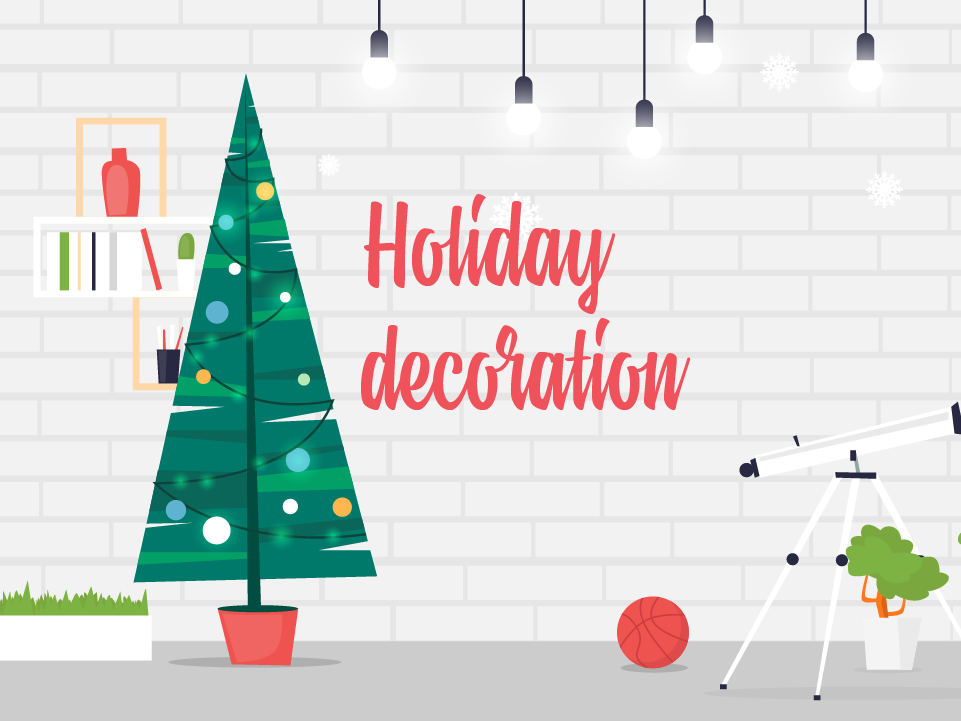
Holiday Decoration
While wreaths are the most obvious holiday decoration you can create with a hula hoop, the possibilities are endless. For Halloween, create a hanging decoration with cut-out bats (you could adapt this for any holiday, using snowflakes for winter, hearts for Valentine’s Day, shamrocks for St. Patrick’s day, or American flags for the Fourth of July).
Another great Halloween idea is to use a hoop to create an oversized spiderweb to hang as decoration. Other Christmas ideas abound--one of the most fun is to use a series of hoops to create a unique and environmentally friendly Christmas tree. Or, you can use a single hoop as the base for an outdoor tree made entirely of lights and a central stick or pole.
We love these unique decorations created by some talented DIY-ers:
#20. Spider Web
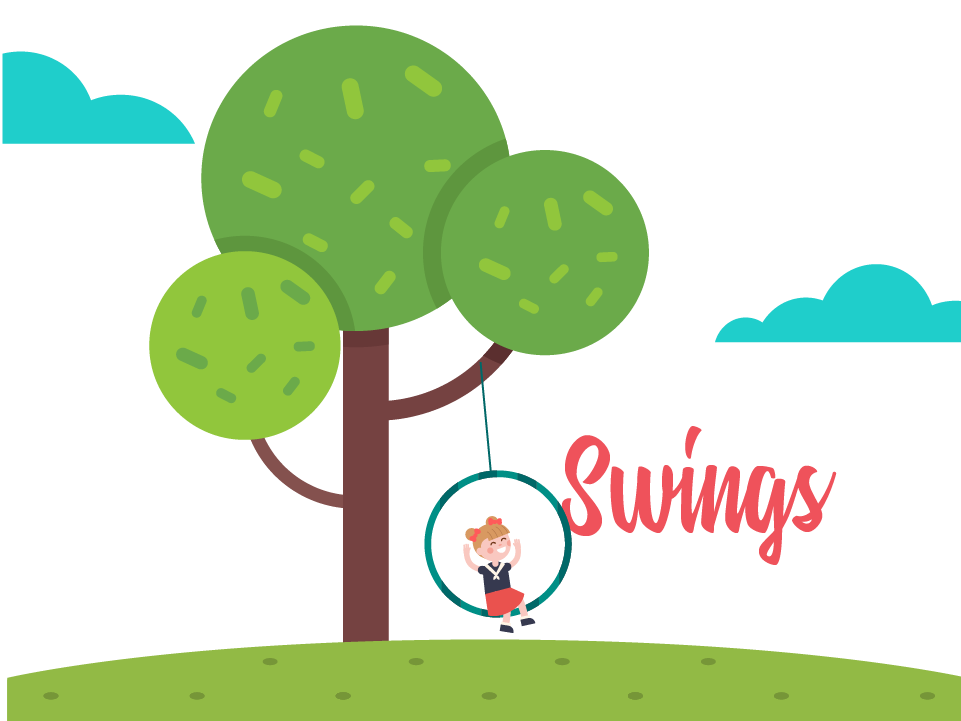
Swings
Hula Hoops also make wonderful swings for the backyard. While you can certainly buy a custom hoop swing, those are pricey and a worthwhile investment primarily for those looking to use the hoop for training, aerial performance, and more. If you merely want a backyard swing for your small children, but don’t have a spare tire to make a tire swing, consider a DIY hoop swing. All you need is a rope, a hula hoop, and something to hang the swing from, such as a post or a tree. Pick a colorful hoop or rope to add an extra playful touch to your new backyard plaything.
Check out this cool hoop swing:
#23. Hoop Swing

Rugs
With their round shape and sturdy build, hula hoops are a natural base for homemade area rugs. There are a lot of options for making a rug from scratch with a hula hoop base. Perhaps the more complicated and more intricate method is to hand finger-knit a rug using the ball of yarn of your choice (nowadays, yarn comes in multicolored and color-shifting balls, so feel free to pick something totally off-the-wall). If you want to repurpose more than just a hula hoop, you can also make a rag rug out of the strips of old t-shirts. It’s a great way to clean out your closet and create a memorable piece for your home.
Get inspired with these unique hula hoop rug designs:
#24. Finger-Knit Rug
#25. Rag Rug

Showers
Do you need to make an outdoor shower? Perhaps for washing the dog? Or maybe you just want a space for the kids to rinse their feet off before coming inside? Or maybe you just need to build a shower in a small space, like your trailer or motorhome? A hula hoop is the perfect base for building an outdoor shower and hanging a curtain around the perimeter of the hoop. Simply hang the hoop, run a hose with a wide nozzle over the top of it, and string a curtain or fabric from the hoop to create privacy. Alternatively, you can place the hoop above a plastic bucket to help capture water for reuse later.
Here are a few examples of outdoor showers for you to try:
#26. Outdoor Shower
#27. Trailer Shower

Wedding and Home Decor
Hula hoops can be used for a variety of home decor, as well as potential wedding decorations. Want to create a decorative wall-hanging or wind chime--hoops are a great base from which to hang anything, including starfish and seashells if you’re going for a beach theme. If you’re planning your wedding, think above the table when it comes to your centerpieces. Hula Hoops covered in greenery with hanging flowers and petals are a striking alternative to plain bouquet on a table. String lights around hula hoops and hang them in your garden to give your yard a romantic gleam after dark. Or cover a hoop in rocks to create unique statues for your garden that will offset your flora and fauna beautifully.
These beautiful designs have been shared over and over on Pinterest boards:
#28. Seashell Windchime
#29. Hanging Centerpieces
#30. Decorative Rock Formation
When it comes to DIY projects with a hula hoop, the possibilities are endless. Go out there and turn your hoop into a thing of beauty.
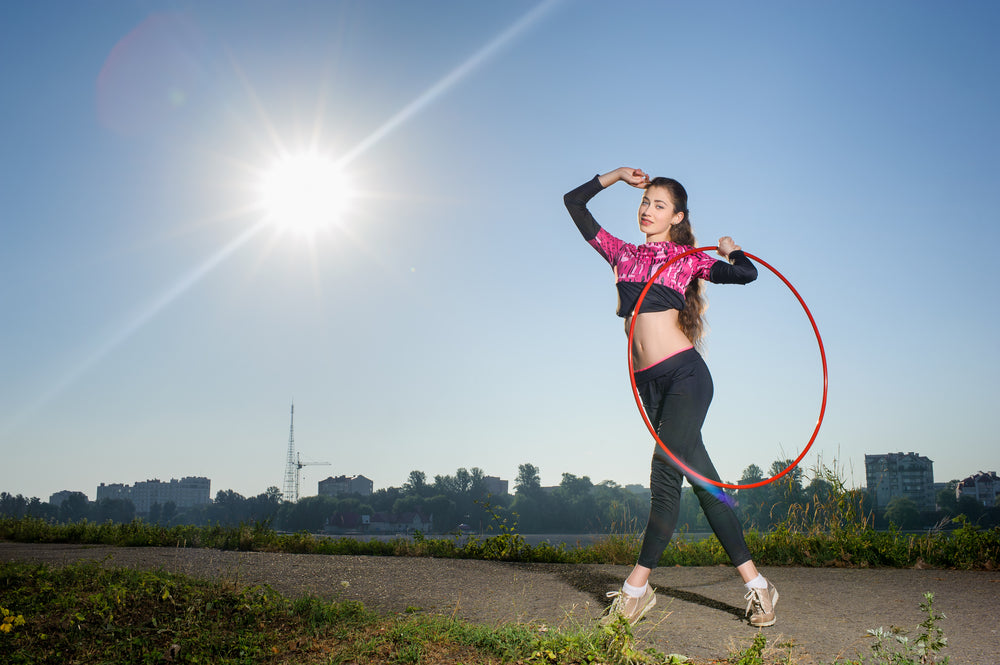
Core workouts are essential for athletes and anyone looking to build strength, endurance, and agility. However, it can be difficult to find the right way to work up a sweat without hurting your joints or falling into the same boring routines you learned in gym class. That’s why so many have incorporated hula hooping into their training.
Hula hooping? Really? If you thought hula hooping was easy, you should watch the Glamour video of Olympians attempting to hula hoop. Because hula hoops force you to build muscle strength and balance at the same time, it can be challenging for even the most fit of individuals. It’s time to take your hoop workout to the next level and try these popular exercises for athletes:
1. Ab Buster
This is a serious workout routine! Set a timer for three minutes. Hula hoop for that entire time period, and then immediately drop to the floor and hold a plank for another three minutes. Repeat this three times. No cheating!
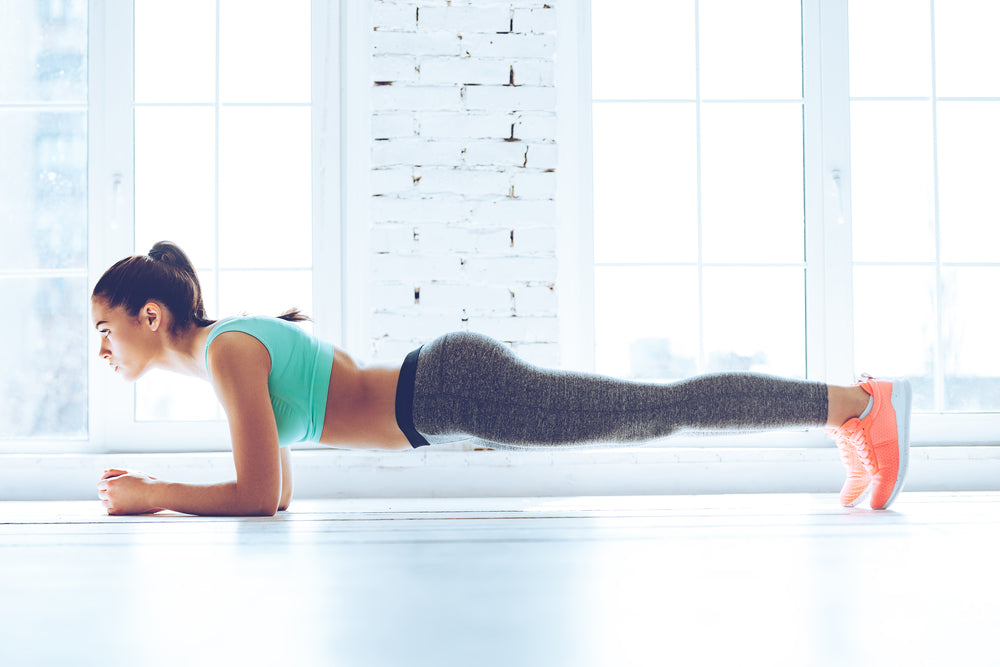
The perfect plank.
Planks engage all core muscle groups. Plus, it has a low impact on your spine and hips. You should add planks to nearly every workout, not just hooping!
2. Mix It Up
Everyone knows about the benefits of traditional hula hooping, where the hoop rests on your hips. However, hula hooping can give you a full body workout! Try changing it up by putting the hoop around your neck, arms, or even legs. It’ll work different muscle groups than you normally do, so you’re guaranteed to feel the burn. Especially if you are recovering from surgery, you can still add toning to your regime with a hoop.
3. Relay
Ready to turn your workout into a competition? Grab a few of your workout buddies and start a good old fashioned relay race! Hoop for ten rotations, then run down and tag a friend. Keep this up as long as you can. Make sure you pick your teammates wisely; you never know who may need more practice at the hoop...
4. Catch Me If You Can
Hula hooping doesn’t have to be in one place. Gently roll your hula hoop on the ground in front of you. Then, run as fast as you can to try and beat the hoop to your finish line. This trains your fast-twitch muscles and adds some much needed variety to your routine. You can also try running with the hula hoop. (Yes, it’s possible! Check out the Hoopathon for Race for Life in the UK.)
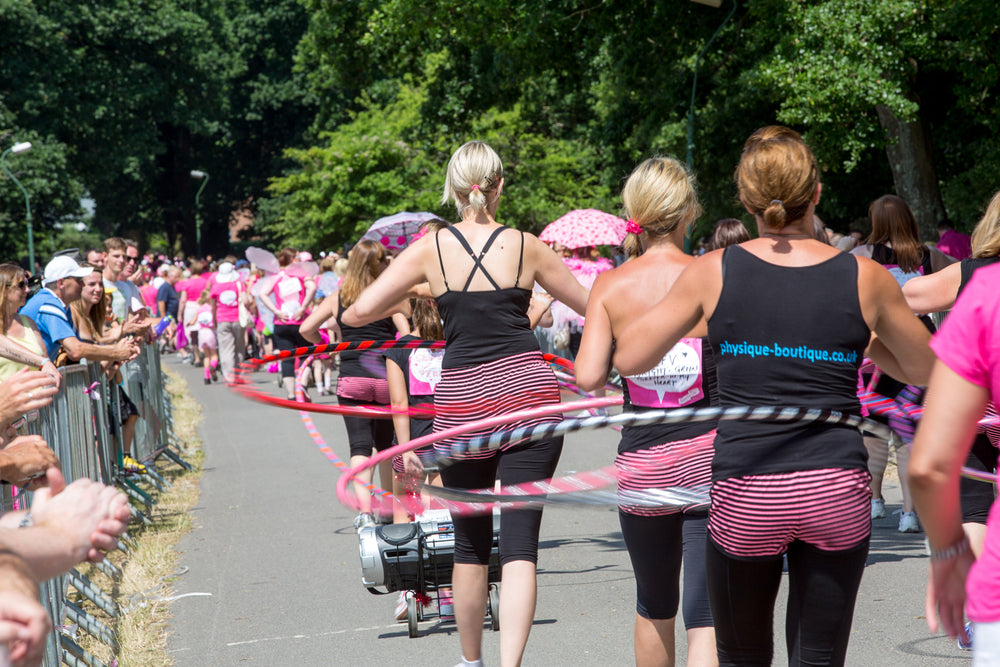
Race for Life in 2009
5. Fartlek Hooping
Runners often practice fartlek training, where the pick a certain point and run to it as fast as they can. Hula hoopers have their own version of fartleks, too! For this exercise, pick a number from 1-1000. Then, hoop as fast as you can until you reach that number of rotations.
6. Slow And Steady
Hula hooping is a great cardio workout, but it can also work wonders for your muscular strength! Try to hoop as slowly as you can. Take caution, though -- it’s harder than you think! By slowing down, you’ll be adding more control to your core (and more power to your abs).
7. Soccer Drills
Everyone remembers stepping up and down on a ball as fast as you could during middle school soccer practice. But, few people know that this can be done while hula hooping! This trains multiple muscle groups and is pretty hard to do. So, it’s a mental exercise as much as it is a physical one.
8. Hop To It
You can use a hula hoop for more than just hooping! Lay a few on the ground, and then hop in and out of them as quickly as you can. You may remember seeing this exercise from movies featuring intense army training--but with tires instead of hula hoops. Remember to pick up your feet as high as you can to maximize the effect. This is great for your muscles and is a good source of cardio!
9. Hoop Tricks
A quick search on Instagram or Pinterest can help you find countless of hula hooping tricks. Try to learn a few. They’re sure to work some new muscle groups! Add music, neon lights, and trending hashtags--you’ll have new followers passionate about your hula hooping in no time.
10. Off And On
All athletes know the best workouts are unpredictable for your body. Once your body knows that to expect, it stops workout as hard. Work your fast AND slow twitch muscles by rotating between hooping quickly and slowly. This is definitely a great way to great in an excellent workout in no time at all!
Next time you’re looking to change up your exercise routine, try to use more of these great hula hooping workouts for athletes. After all, variety is the spice of life.

By now, we all know about the incredible health benefits of regularly exercising with a hula hoop! But, no matter how good it is for you, it can still be super difficult to find a hula hoop that is convenient enough to pack into your bag and take on a trip (whether that be for work or please). Fortunately, we have a solution to all your problems! Keep reading to learn more about the magic of collapsible hula hoops and where to find them!
Hula hooping is an all-in-one form of exercise! It provides a great cardio workout, allows you to tone your entire body, and gives you the opportunity to strengthen muscles in those hard to reach areas like your lower belly. These waist slimming benefits are awesome, but we’ll be the first to admit that dragging a hula hoop around with you everywhere you go can be super awkward!
After all, who wants to carry around a giant hunk of plastic? Not only is it inconvenient, it will bring on some serious stares from people that you may not even know! Thankfully, Hoopnotica Hoops allow you to get the great fat burning benefits of a hula hoop workout no matter where your life journey may take you!
No one likes being the subject of unwanted attention. And, trust us, traveling with a hula hoop will CERTAINLY give you plenty of unwanted attention! That’s where Hoopnotica Hoops come in. They give you all the benefits of a hooping workout without all the clumsiness!

The secret behind Hoopnotica Hoops is their unique collapsible design. With just a few flicks of the wrist, users can break their hoop up into six individual segments. Then, they can be strung together with an handy travel strap that helps to keep all your segments together so that you can take your workout gear with you wherever you go.
Hoopnotica Hoops also come with a DVD to help give you a headstart on your fitness goals. In just a few minutes a day, you can work alongside their guide to get the body you’ve always dreamed of and hoped for.
The next time you have to go on a business trip or a long weekend with friends, forget about trying to use the tiny hotel gym or navigate a running route in an unfamiliar city. Just remember to pack your Hoopnotica Hoop and you’ll be good to go! Fortunately, their collapsible design, travel strap, and inspiring videos are all you need to get in a great workout while you’re on the go!
Long gone are the days of bumbling around awkwardly trying to fit your hula hoop through a tight door frame or trying to convince the Transportation Security Administration agents to let you bring it on the airplane with you. With Hoopnotica Hoops, you can get the workout you crave and the results you desire. If you’re wondering about where to get hula hoops that are easy to pack, look no further than Hoopnotica Hoops!

Are you trying to slim down, tone up, or just stay in shape? Cardio exercises such as running, biking, and swimming are the perfect way to meet your fitness goals, but there’s just one problem: you have to do these outside unless you have access to a gym. Exercising outdoors isn’t a problem for three out of the four seasons, but when the temperatures begin to drop, the last place you want to be is finishing up a nice, long run. So, how can you continue to work towards your fitness goals during the winter? Grab a hula hoop!
Hula hooping can be done anywhere, so no matter how hot or cold it gets outside, you can still complete a workout. Here are some of the many benefits of hula hooping for exercise:
Inexpensive.
Unlike many other forms of exercise, you don’t need to invest in expensive equipment in order to start hula hooping. In fact, the only piece of equipment you will need is an inexpensive hula hoop.
Portable.
If you were to buy a treadmill or stationary bike, you would need to clear out a lot of room within your home to make space for this equipment. However, hula hoops don’t take up much room, so you don’t need to have a gym at home in order to practice hula hooping on a regular basis. Travel hoops, which are traditional hula hoops that can be broken down into smaller pieces, are even more portable and easy to store, so look for these if you really don’t have much space.
Exciting.
During a long run or bike ride, you have probably found yourself questioning how much longer you have until you’ve reached your time or distance goal, but these questions don’t pop into your mind when you’re hula hooping for exercise. Because hula hooping is so different from other exercises, you won’t find your mind wandering—you’ll be too focused on the fun!

Easy for everyone.
Some people physically can’t run or bike ride because of certain injuries or aches and pains. Hitting the pavement repeatedly during a run can put a lot of stress on the joints, and lead to major injuries over time. But, hula hooping is a low impact exercise, so almost everyone can do it. Swinging a hula hoop around your hips will not put a great deal of pressure on your joints or bones, so you’ll get a great workout without hurting your body.
Core strength.
Most cardio exercises can burn calories without building up strength, but hula hooping can do both. The movement required to keep the hula hoop in motion will challenge all of your core muscles, so after the winter is over, you may notice a firmer midsection. Not only will this help you feel more confident, but a strong core can also improve your posture and balance.
Now that you know the many benefits of hula hooping for exercise, try to incorporate this workout into your regular routine. You may need to start off slow if you’re not used to the movements, but over time, you’ll become a hula hooping—and fitness—expert!
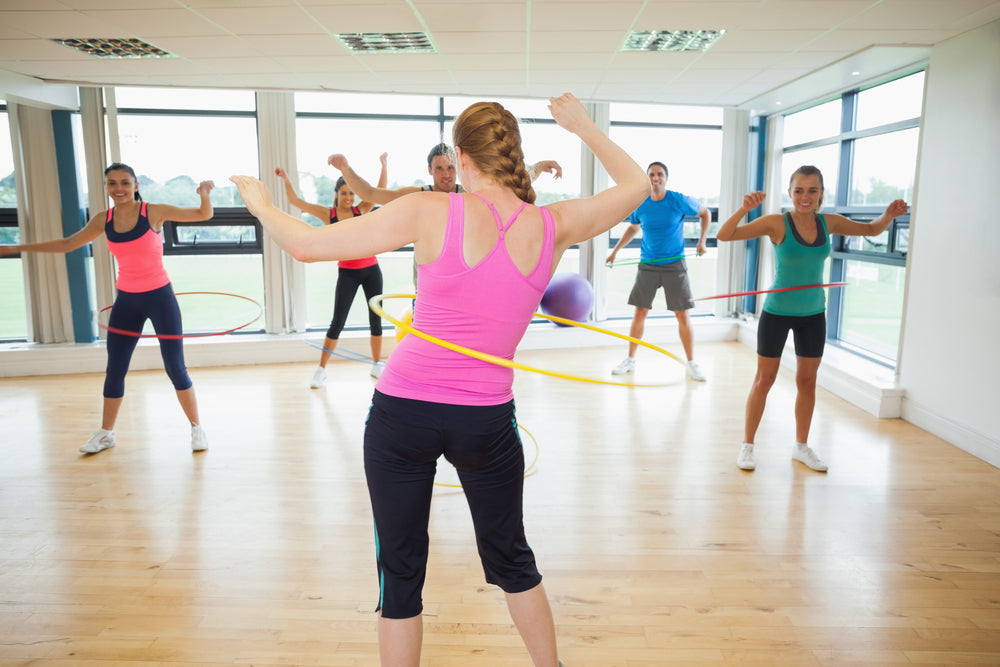
Hula hooping has become one of the latest fitness trends, and for good reason. It offers a wealth of health benefits that range from working out up to 30 of your body’s muscles and burns more than 400 calories an hour! Talk about a great workout!
Hula hooping has been around for a long, long time; so why does it seem like people are only recently realizing the incredible health benefits that this circular device that spins around the hips offers? If you are just getting into hula hooping for fitness and you are wondering how it has evolved from a children’s play thing into a powerful tool for health and wellness, read on to learn more about the evolution of the hula hoop.
Ancient Greece
While nobody knows for sure how hula hoops became a part of fitness regiments, records do indicate that they were used as far back as ancient Greece. Known as some of the greatest and strongest athletes in history, the ancient Greeks used hula hoops for exercise. While there is no evidence that proves hoops were used in the early Olympic games, one has to wonder if they were used as a tool to get into shape for the events.
Ancient Native American Dance
Records indicate that Native American tribes as far back as the 1400s used hula hoops as tools in their dance as a means of telling stories. A circle with no beginning or end, the hula hoop was used by many tribes to signify the continuous circle of life.
Dancers would use several hoops of various sizes to represent a variety of symbolical animals, including eagles, butterflies, coyotes and even snakes. Today, Native American tribes carry on the tradition of dancing with hula hoops to tell the stories that their forefathers shared. The evidence of the hula hoops providing valuable fitness benefits can be seen in the depictions of ancient Native American hoop dancers who were very physically fit, and can be seen in the exceptional physiques of those who dance with them today.
Mainstream Modern Culture
Hula hoops came into the mainstream in the late 1950s. In Australia, children played with hoops made of bamboo and twirled them around their waists for exercise. A popular Australian toy manufacture, Toltoys, began making hula hoops out of plastic when they became so popular that the production of bamboo hoops could no longer meet the demand.
Hula Hoops in the US
The use of hula hoops as children’s play things spread to the US when the founders of Wham-O, a California-based toy company, supposedly visited Australia, saw how popular the toys were, and decided to start mass producing and marketing them in the US.
This ‘new’ toy gained rapid popularity in the late 1950s, becoming one of the most beloved children’s activities in the US. When sales of hula hoops started to lag, Wham-O started to modify their initial design, placing ball bearings inside the tubes so that they would make noise and further attract the interest of children. The ball bearings also added weight to the hoops, stepping up the physical fitness factor that they provided.
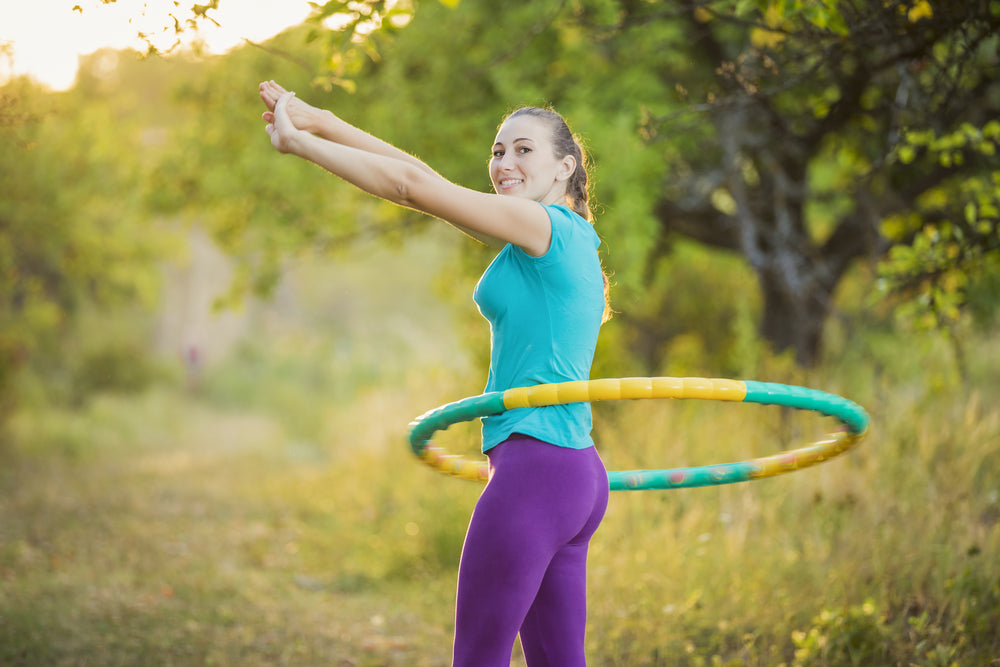
Hula Hoops for Fitness
The benefits of using hula hoops for exercise have long been known, but only in recent years has the fitness hooping trend really taken off. In looking for ways to make exercising more interesting, enjoyable and engaging, people began to add hula hoops to their workout routines. The hoops provided exceptional results, which ushered in the use of different types of hula hoops, such as the weighted hoop, and of the latest and most advantageous exercise crazes.
If you haven’t yet jumped on the fitness hooping bandwagon, you really need to give it a try. After just a few sessions, you will realize the complex benefits such a simple device can offer.

Since their arrival on the scene in the 1950s, hula hoops have long been a fun way to exercise. And with the rise of circus fitness in recent years accompanied by the rising art of hoop and aerial dance, hula hooping is more popular than ever!
But did you know that besides being a fun, relatively inexpensive way to work out--hula hooping also comes with a lot of health benefits as a full-body workout tool?

1. Coordination
Like many sports, hula hooping requires and helps build hand-eye coordination. To keep a hoop spinning around your waist requires your brain to work hand-in-hand with your muscles to maintain a steady directional movement. It’s like patting your head and rubbing your tummy, but with a hula hoop! What’s more -- hula hooping requires you to dig in your feet a little to maintain balance and stability, so it also helps improve your balance overall. If you really want to challenge your brain, you can branch outside of hula hooping in one direction around your waist and learn a variety of hula hoop tricks, including hand hooping, doubles (hooping with two hoops), and more. Training your body to do these tricks will strengthen your neural pathways and result in a marked improvement in your coordination.
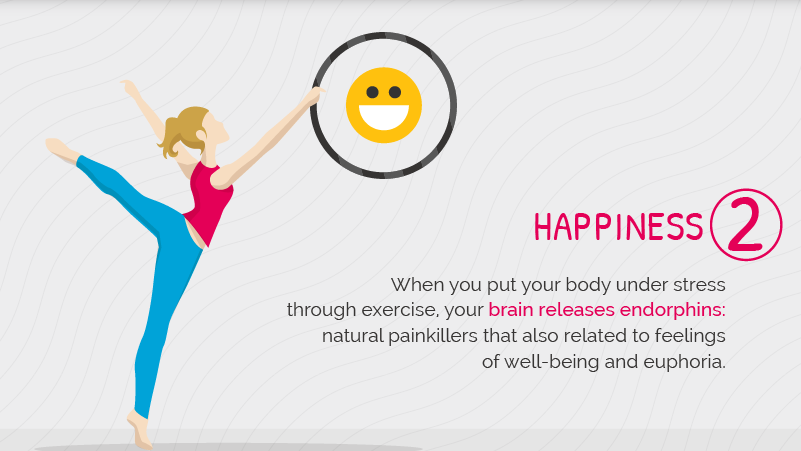
2. Happiness
It’s a well-known fact that exercise helps your brain release endorphins, which are related to feelings of safety, well-being, and intense happiness. But hula hooping can promote an even higher level of euphoria by allowing you to reconnect with your childhood -- many people say hooping helps them engage with a more spontaneous, playful side of themselves that they might have to keep under wraps at work or in a more aggressive form of exercise. Because hula hooping is associated with childhood, it’s rare to see someone without a smile on their face while they hoop -- you are more likely to feel more vibrant and youthful after hula hoop use. Many even describe a boost in self-confidence and self-expression after regular hula hooping. The repetitive motion of hooping and body engagement can also act as a form of meditation for some, allowing your workout to be a calming, restorative exercise that promotes happiness, well-being, and peace.

3. Heart Health
It might seem strange, but hula hooping is actually fantastic cardiovascular exercise. If you hate running or jumping on a machine at the gym, a hula hoop is a great way to get cardio in each week. The heart is the muscle that needs more of a workout than any other part of your body, and you can feel your heart rate start to race the more vigorously you hula hoop. If you want to make your workout more intense and push your heart rate up, consider multiple hoops or hula hooping tricks that work your whole body. Cardiovascular exercise can help promote lifelong health and reduce the risk of heart disease -- who knew that a plastic hula hoop could give your heart such a workout?
4. Spine Strength
It might not seem like it, but it’s pretty impossible to move your hips without engaging your spine. The rhythmic motion of the hoop back and forth increases blood flow to your spine, which can improve your spine strength and flexibility if done regularly. Your spine is a powerful, yet delicate instrument in your body and giving it a proper workout and stretch without overdoing it (which hooping is perfect for) is a prime way to promote spine stability in the long term. Hooping is also a low impact activity, so if you have a bad back or sensitive spine, it’s a great way to strengthen your spine and promote back health without risking injury to yourself.

5. Core Strength
Given that hula hooping primarily occurs around your waist, it should come as no surprise that it’s a great way to work out your core. Regular hooping can strengthen your waist and stomach muscles. If your waist is a problem area for you, hula hooping can be an excellent way to target this area without running, executing specific aerobic exercises, or dieting. Hula hooping uses your abdominal muscles (upper and lower) as well as your back muscles, all of which can help burn abdominal fat and tone your midsection. When you’re rocking that six-pack in your bikini body, you can thank your hula hoop.

6. Muscle Tone
Though it may be a killer core workout, hula hooping doesn’t just work out your abdominal region. It can easily be a full body workout, exercising up to thirty different muscles throughout your body. As you wiggle around to keep the hoop moving, you’re using nearly thirty different muscles and special workouts can help target particular areas. The American Council on Exercise found that waist hooping can burn approximately 400 calories per hour. Though waist hooping alone works out a multitude of muscles, you can also hoop on your chest, arms, feet, hands, shoulders, hips, and more. This can make your workout more intense and target areas you want to focus on.
There are a multitude of hula hooping moves, and you can even buy Special DVDs with workout programs designed to help maximize your full-body hula hooping workout. Depending on your posture, the placement of your feet and hips, and the part of your body circling the hoop, you can work everything from your abdomen to your glutes to your biceps. Here are three simple moves you can try at home to get a killer hoop workout.

Now, grab your hoop and have some fun!

Hula hoops aren’t just for the waist. Dancing with hoops—or “hooping”—incorporates the arms, legs, neck and anywhere else the hoop can twirl. To add to the crazy coolness, hooping encourages using multiple hoops at once for a hypnotic hoop-centric routine.
Hooping is serious. There are professional competitions that honor the best hooping routines—some of them featuring as many as 50 hoops at once. Hooping.org even hosts a Hooping Idol competition to find the best hoopers.
Dizzying twirling displays feature different hued hoops some with unique designs or even lights. Hooping techniques can vary with the individual. There are Native American-inspired hooping, LED hooping, Hip Hop hooping and more.

The 5 P’s of Hooping
For beginners who are unsure where to begin with the hoop, start with a bigger hoop and start slow. Remember that bigger hoops twirl slower, so create a dance that involves slower beats.
Hooping.org addresses the 5 P’s that every new hooper should know: patience, practice, personality, perseverance and pass it on. The last “P” simply means that hoopers should share their love and passion of hooping with others.
Before hooping, hoopers must find their hoop and not all hoops are made for hooping. When using hoops for dance, the weight matters. Say yes to heavier hoops if just beginning the hoop dream. Heavier hoops are easier to control. However, bigger hoops twirl with less zeal and speed. Do not use weighted hoops for hooping, as weighted hoops should only be used for exercise.
Those with more hoop experience should opt for lighter hoops, especially when moving with fast beats and using multiple hoops on different areas of the body.

Shop for Dance Hoops
Many hooping sites offer online stores that sell hoops. You can find a great resource to find different hoops and their manufacturers. And, of course, there are also brick and mortar stores.
When shopping for hoops, always keep weight and size in mind. Smaller hoops can be used on the arms or legs. Bigger hoops can be used around the waist. Costs will vary by manufacturer, as will the colors and designs of the hoops. Many well-known sporting goods stores carry a variety of hoops…avoid any hoop that is labeled for fitness, however, as this often indicates a weighted hoop. You can also shop for travel hoops to use for on-the-go.
Elaborate hoops are always available, but save the craziness for competition or when hooping is mastered. Start with a basic heavier adult-sized hoop…then practice, practice, practice.
No matter what size hoop is used, every hooper burns calories doing what they love—keeping those crazy hoops in motion to the music. Some hoopers claim to burn hundreds of calories. However, the fun of the experience is the true benefit of hooping—burning calories is just a bonus.
Hoops incorporated into dance routines have always held a unique popularity. Now hooping has elevated to an international phenomenon. From light-up hoops that offer a fun flash to techno music backbeats to Native American-inspired tribal hoop dances, hooping has evolved into an art form that illustrates the creativity of each performer.





